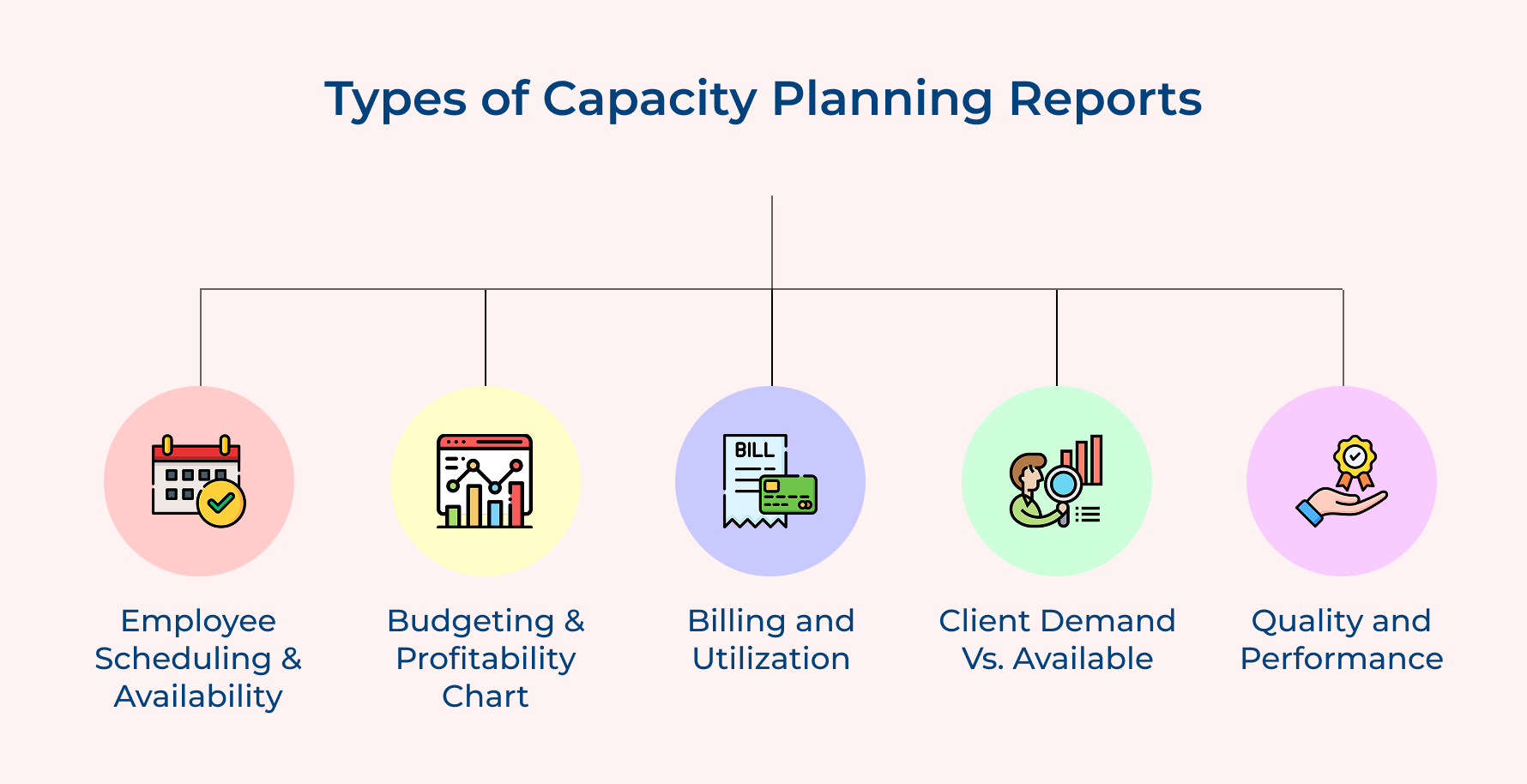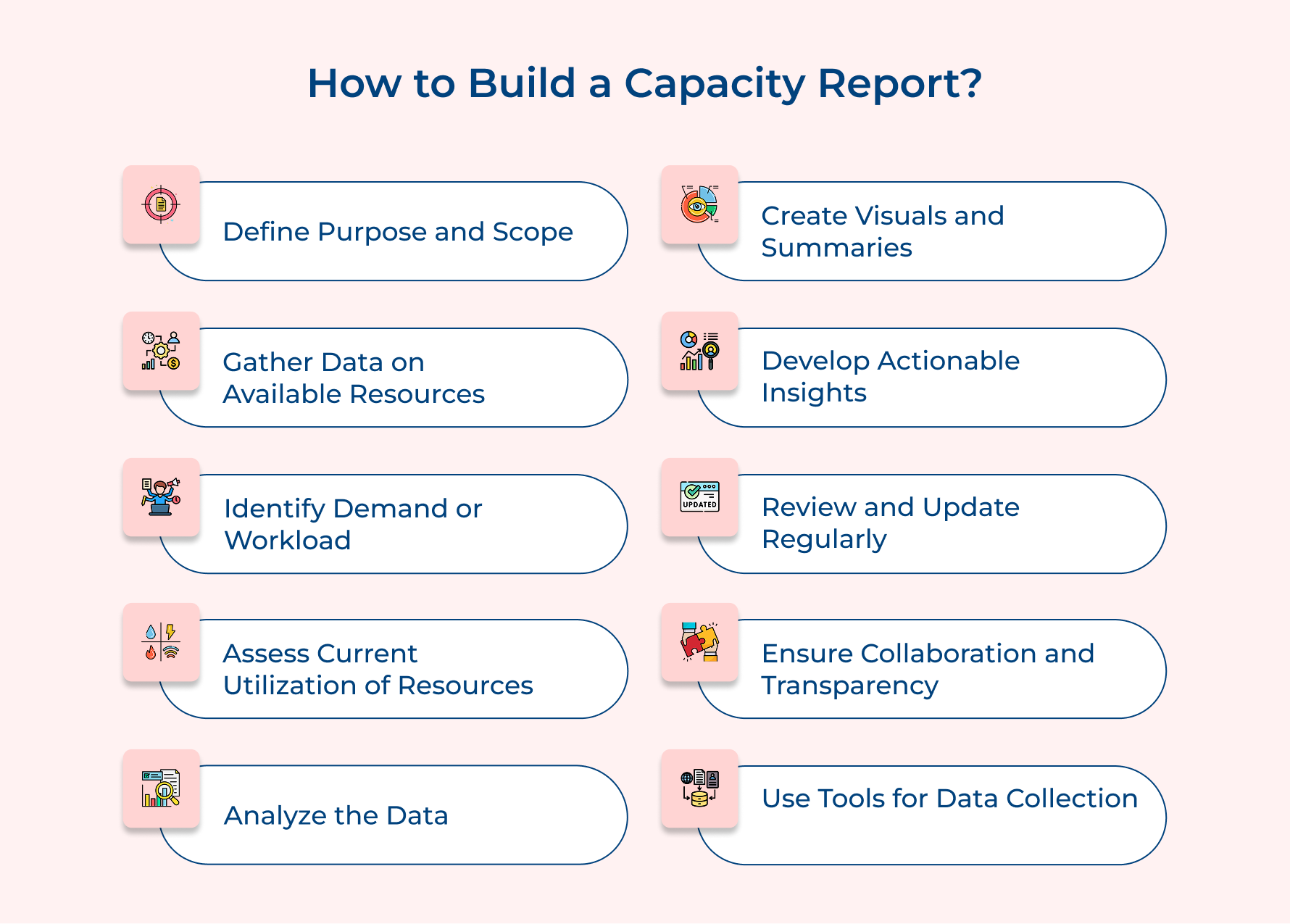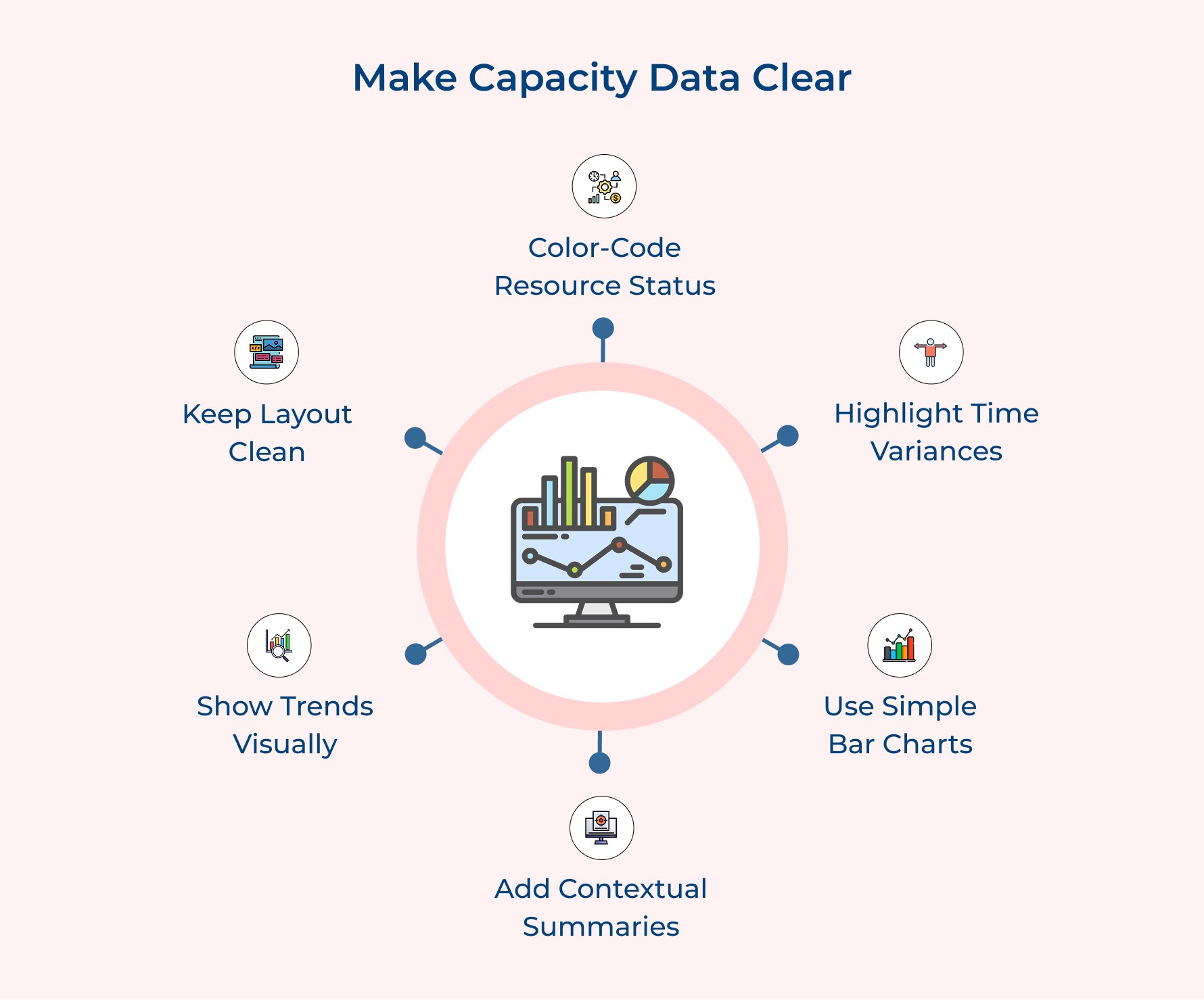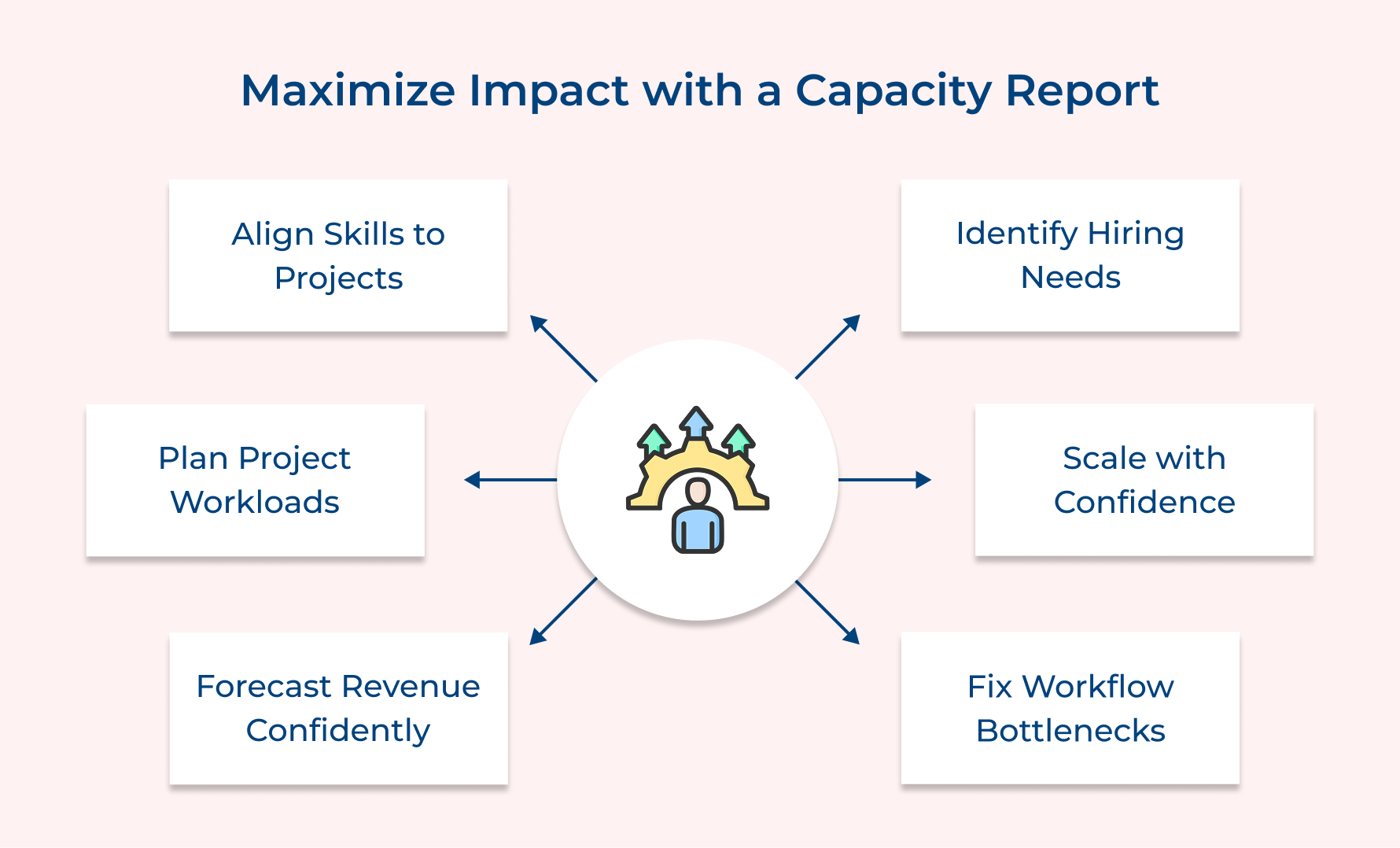A Guide to Capacity Report: Types & How to Build One

Key Highlights:
- A key capacity report helps allocate resources efficiently, ensuring balanced workloads, preventing burnout, and improving project delivery.
- Accurate resource data enhances revenue forecasting, enabling agencies to predict billable hours.
- Regular capacity monitoring helps identify bottlenecks, improve workflows, and optimize performance by addressing resource inefficiencies in real-time.
Businesses often face challenges in resource allocation, leading to inefficiencies, missed deadlines, and overburdened teams.
Without a clear understanding of available capacity and demand, organizations can end up underutilizing resources or overcommitting, negatively impacting growth as well as productivity.
A well-crafted report provides a detailed analysis of resources, workloads, and future demands, helping businesses identify gaps while optimizing operations.
Let us explore how to create and use a capacity report to enhance resource allocation as well as improve overall efficiency.
What is a Capacity Report?
A capacity report helps organizations assess their ability to meet demands over a period of time. It highlights resource gaps, bottlenecks, and opportunities for optimization. By analyzing different types of capacity reports, businesses can plan for additional projects and allocate additional resources effectively.
Identifying shortfalls early prevents disruptions, ensures cost efficiency, and improves ROI. With data-driven insights, companies can optimize workforce, technology, and infrastructure to stay prepared for future growth as well as operational needs.
Key objectives:
- Resource optimization: Maximize the efficient use of existing resources while minimizing waste and redundancy.
- Risk mitigation: Forecast potential capacity constraints and develop contingency plans to maintain operational continuity.
- Strategic planning: Support informed decision-making for growth initiatives, capital investments, and resource allocation.
- Performance enhancement: Track and analyze capacity utilization metrics to improve operational efficiency.
Types of Capacity Planning Reports
Capacity planning reports help businesses assess resource availability and plan for future demands. Different types focus on workforce, technology, infrastructure, and operations.
Employee Scheduling & Availability Report
This report gives a clear picture of who’s working, who’s off, and who might be overloaded. It breaks down billable vs. non-billable hours, tracks downtime, and flags scheduling conflicts. Managers use it to ensure fair workload distribution, prevent burnout, and identify gaps where additional resources might be needed.
Budgeting & Profitability Chart
Want to know if your projects are making money? This report analyzes costs vs. revenue, tracking billable rates, project margins, and overhead expenses. It helps businesses make smart decisions on pricing, hiring, and resource allocation to keep profits healthy while avoiding financial bottlenecks over a period of time.
Billing and Utilization Capacity Report
How productive is your team? The report compares billable hours to targets, tracks utilization rates, and highlights unbilled time. It’s a great tool for optimizing billing efficiency, ensuring resources are fully utilized, and identifying where productivity improvements can be made.
Client Demand vs. Available Capacity Report
The report here maps client demand against available resources, factoring in pipeline projects and resource needs. It helps leadership decide if they need to bring in additional resources or adjust timelines to keep delivery on track.
Quality and Performance Capacity Report
The capacity report connects resource utilization with performance metrics like client satisfaction, deadlines, and error rates. It ensures teams maintain high-quality work while optimizing their capacity, preventing burnout, and improving efficiency across projects.
How to Build a Capacity Report?
Creating a capacity report helps you assess resource availability, workload, and efficiency. Follow these steps to build a clear, data-driven report.
1. Define the Purpose and Scope
Clarifying the purpose and scope of your capacity report is key to setting a clear direction. It helps you decide which resources or departments to focus on, whether that’s labor, equipment, or financial capacity.
Without a clear purpose, you might end up collecting unnecessary data that doesn’t help with decision-making. Narrowing your focus helps make the report more actionable and aligned with your goals, regardless if it’s optimizing resources, prioritizing projects, or managing teams.
Tips:
- Define your objectives upfront, like evaluating resource use or workload balance.
- Get input from key stakeholders to make sure all necessary areas are covered, avoiding any important gaps.
2. Gather Data on Available Resources
When building a capacity report, start by collecting data on the resources you currently have—like staff, contractors, equipment, technology, and your budget.
For example, if you’re managing a tech team, you’d want to know how many developers you have, what software or tools they’re using, and how much budget you have allocated for new hires or training.
Without this data, it’s impossible to tell if you’re overusing certain resources or if some are sitting idle. Understanding what’s available lets you make informed decisions, like if you need to hire more staff, invest in new equipment, or reassign team members to different projects.
Tips:
- Keep your resource data updated to ensure the capacity report reflects current conditions.
- Track how resources are being used over time to spot potential issues, like staff burnout or unused equipment.
3. Identify Demand or Workload
Identifying demand or workload means estimating the work required across projects, tasks, or clients—both current and upcoming.
Knowing this helps you assess if your team’s current resources can meet future demands. For instance, if your marketing team is already stretched thin and a new campaign comes up, you may need more hands on deck.
You can see if there’s a gap by comparing demand against your available resources. If demand exceeds your capacity, solutions like hiring more people or adjusting project timelines might be necessary to balance things out.
Tips:
- Keep a dynamic project pipeline to anticipate future demand and avoid last-minute surprises.
- Stay in regular communication with clients to understand their evolving needs and keep your workload predictions on track.
4. Assess Current Utilization of Resources
Evaluating how effectively current resources are used involves reviewing the allocation of staff, equipment, and technology.
Resource utilization assessment highlights inefficiencies, such as underutilized or overstretched resources. Addressing these imbalances improves operational efficiency and prevents resource bottlenecks.
Reviewing resource utilization data helps determine if adjustments are necessary. This ensures more effective resource distribution, preventing overwork or idle resources.
Tips:
- Regularly monitor staff and equipment utilization to identify any resources that are overburdened or idle.
- Use time-tracking tools to gather real-time data on how resources are being used and adjust accordingly.
5. Analyze the Data
Data analysis is all about comparing the resources you have against the workload demands to spot any gaps or inefficiencies.
Without proper analysis, your capacity report won’t give you the clear insights you need to make decisions. The step helps you catch potential capacity issues early, so you can address them before they turn into bigger problems.
Analyzing the data helps uncover any mismatches between what you have available and what you need.
Tips:
- Use data visualization tools like graphs or charts to make trends and patterns clearer.
- Regularly reassess your analysis approach to keep up with changes in resources or market conditions.
6. Create Visuals and Summaries
Creating visuals as well as summaries is all about turning raw data into clear, easy-to-understand charts, graphs, and tables that highlight key metrics.
These visuals make it easier for stakeholders to spot trends, such as actual time spent versus allocated time, and identify where adjustments in resource management are needed.
By presenting data in a visual format, you make key findings more digestible, allowing leadership and teams to quickly assess capacity as well as make data-driven decisions.
This not only enhances clarity but also ensures that resource management decisions are informed and timely, helping avoid overuse or underutilization of resources.
Tips:
- Use color-coded charts (green for good, yellow for at risk, red for critical) to quickly convey the status of resources.
- Include key summary points with each visual to ensure that the context and implications are clear to all stakeholders.
7. Develop Actionable Insights and Recommendations
Actionable insights involve interpreting the data to provide specific recommendations, such as hiring, reallocating resources, or adjusting project timelines.
The report becomes just a collection of data without clear recommendations. Providing actionable insights turns the report into a guide for decision-makers.
Insights lead to strategic decisions about resource allocation and project execution, helping to address identified capacity gaps or inefficiencies.
Tips:
- Align recommendations with company goals, ensuring they are actionable and directly tied to improving efficiency.
- Prioritize recommendations based on impact and feasibility, focusing on areas with the highest capacity constraints.
8. Review and Update Regularly
Regularly reviewing and updating the capacity report is essential to keep it aligned with the evolving state of resources, workloads, as well as business goals. As conditions change over time, the report must reflect these shifts to stay relevant.
Setting a period for regular updates ensures that the report remains accurate and actionable, enabling businesses to adjust as needed. Frequent reviews also help teams, both individually and as a whole, identify as well as correct any resource imbalances before they become bigger issues.
Tips:
- Set a consistent update schedule to ensure your report reflects the latest data on resources and demand.
- Automate data collection where possible, such as integrating time tracking or project management software to reduce manual updates.
9. Ensure Collaboration and Transparency
Collaboration as well as transparency involve key team members in the creation of the report and sharing the findings with stakeholders to align decision-making.
Involving multiple perspectives ensures comprehensive insights. Transparency builds better collaboration across teams, helping align resources with demand and solving capacity issues collectively.
Sharing the report with relevant teams encourages input and collaboration, leading to more accurate as well as actionable insights for addressing capacity challenges.
Tips:
- Schedule regular meetings with key stakeholders to discuss findings and adjust strategies based on feedback.
- Create open communication channels to ensure transparency and quicker responses to capacity challenges.
10. Use Tools for Data Collection and Reporting
Tools such as spreadsheets, project management software, and time-tracking apps streamline data collection, making it easier to report on capacity as well as resources.
Using the right tools increases efficiency and accuracy in data collection. These tools automate processes, ensuring that the report remains up-to-date and actionable with minimal manual effort.
Choose tools that integrate well with existing systems. These tools should track resource usage, project timelines, and budgets effectively, helping to create accurate reports along with real-time capacity reports.
Tips:
- Invest in tools that are scalable to meet your future reporting needs as your business grows.
- Train your team to use these tools effectively, ensuring that data entry is accurate and timely.
Benefits of Effective a Capacity Report
A well-crafted capacity report offers numerous benefits, ensuring that your team operates at its peak and your business grows sustainably. Here’s how:
- Resource allocation mastery: Helps match team skills with project needs, ensuring balanced workloads and preventing burnout. It leads to better project delivery and team satisfaction.
- Project pipeline management: Capacity reports allow agencies to assess if they can take on additional work, enabling informed decisions on new clients and projects.
- Revenue forecasting accuracy: Accurate resource data allows agencies to predict billable hours and forecast revenue, ensuring consistent cash flow as well as proactive management.
- Strategic hiring decisions: Identifies skill gaps and justifies hiring decisions, helping agencies plan staffing needs based on actual capacity, not assumptions.
- Business scaling insights: Provides key data for strategic expansion decisions, allowing agencies to plan growth based on realistic capacity assessments.
- Performance optimization: Regular capacity monitoring highlights bottlenecks, enabling teams to improve workflows and efficiency by addressing issues based on real data.
Boosting Organizational Performance with Detailed Capacity Report
A well-constructed capacity report is vital for businesses looking to optimize resources and improve operational effectiveness. It highlights resource availability, current workloads, and future demands, offering valuable insights for data-driven decision-making.
Regularly reviewing and updating the report helps businesses recognize capacity challenges as well as optimize resource allocation, ensuring efficient operations.
Leveraging the capacity report enables businesses to manage demand effectively, streamline processes, and stay competitive in fast-paced industries.
Limit time — not creativity
Everything you need for customer support, marketing & sales.
Neeti Singh is a passionate content writer at Kooper, where he transforms complex concepts into clear, engaging and actionable content. With a keen eye for detail and a love for technology, Tushar Joshi crafts blog posts, guides and articles that help readers navigate the fast-evolving world of software solutions.



